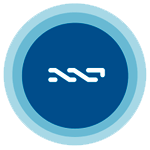Cryptocurrency

Cryptocurrency is digital currency that uses cryptography to verify financial transactions and control the creation of new currency units. Transactions are recorded in a distributed ledger, usually a blockchain, that can be viewed and verified by all users of the cryptocurrency. The decentralized nature of the cryptocurrency system means that no centralized authority, such as a government or bank, is required to regulate, control, or issue the currency. Cryptocurrencies can be stored in digital wallets, like MetaMask.
Cryptocurrency was featured as a top term of 2014.
Examples of cryptocurrencies
As of 2023, according to CoinMarketCap there are over 26,137 cryptocurrencies, with varying levels of popularity and activity. Some popular or notable cryptocurrencies are listed below.
| Name, year founded, trading symbol(s) | Icon | Description | Market cap (December 2023, USD) |
|---|---|---|---|
| Bitcoin 2009 BTC, XBT |
 |
The "original" cryptocurrency, proposed by Satoshi Nakamoto (a pseudonym) in the 2008 white paper, Bitcoin: A Peer-to-Peer Electronic Cash System. Bitcoin's underlying technology is an open-source variation of hashcash, a PoW (Proof-of-Work) algorithm that rewards users for "mining" subsequent blocks in the chain. Bitcoin's development is promoted by the bitcoin Foundation, a non-profit organization founded in 2012. | $833,050,174,734 |
| Ethereum 2015 ETH |
 |
An open-source blockchain computing platform, released on July 30, 2015. Ethereum operates as a decentralized, Turing-complete VM (virtual machine). The VM runs scripted, conditional transaction events known as "smart contracts." The cryptocurrency tokens, called "ether," may be generated or exchanged automatically based on successful completion of a smart contract. | $275,127,155,410 |
| Binance Coin 2017 BNB |
 |
The cryptocurrency issued by Binance, a cryptocurrency exchange founded in China in 2017. Shortly after its founding, Binance moved its headquarters to Japan, and later Taiwan, in anticipation of China's 2017 ban on cryptocurrency trading. | $47,230,339,809 |
| Solana 2020 SOL |
 |
A cryptocurrency for use with DApps (decentralized apps), Solana was released in March 2020. It originated from the Solana Labs project, which was founded by Anatoly Takovenko and Greg Fitzgerald. Solana was designed to improve scalability with PoH (proof-of-history) and PoS (proof-of-stake) consensus. | $47,230,339,809 |
| Ripple 2013 XRP |
 |
Operated by Ripple Labs, Inc., Ripple is a decentralized currency exchange and financial transfer system that provides real-time, individual, irreversible financial transactions, with negligible fees. | $33,289,271,169 |
| Dogecoin 2013 DOGE, XDG |
 |
Originally introduced as a "joke currency" based on the Internet meme of a Shiba Inu dog, its community grew quickly and somewhat unexpectedly. | $12,766,999,111 |
| Litecoin 2011 LTC |
 |
An alternative to bitcoin released on October 7, 2011. Its primary differences from the bitcoin blockchain are a shorter block generation time and an increased maximum number of tokens. It was created by MIT graduate and ex-Google employee Carlie Lee as a personal project in his spare time. | $5,407,673,007 |
| Bitcoin Cash 2017 BCH |
 |
A fork of bitcoin that uses larger-sized blocks in its chain, permitting more transactions per block. At the time of its release, owners of bitcoin automatically owned the equivalent number of Bitcoin Cash tokens. | $5,089,613,932 |
| Stellar 2014 XLM |
 |
An open-source payment network designed to allow "cross-border" transactions between different cryptocurrencies. | $3,635,673,344 |
| Ethereum Classic 2015 ETC |
 |
A community-driven continuation of the original Ethereum blockchain initiated in July 2016, in rejection of a hard fork to the original Ethereum blockchain created in May 2016. | $3,163,793,783 |
| Monero 2014 XMR |
 |
Released on April 18, 2014, Monero uses an obfuscated ledger to anonymize the sender, receiver, and amount of all transactions. This approach enhances privacy, but has drawn criticism because it appeals to cybercriminals operating on the dark web. | $3,034,248,769 |
| NEO 2014 NEO |
 |
Originally released in February 2014 with the name Antshares, NEO are indivisible cryptocurrency tokens transacted with smart contracts executed on the platform. Transaction fees are paid with a separate currency called GAS, generated with NEO tokens. | $1,020,700,997 |
| EOS 2018 EOS |
 |
The cryptocurrency of EOS.IO, a decentralized smart contracts VM platform launched on January 31, 2018. | $948,921,077 |
| Dash 2014 DASH |
 |
A fork of bitcoin, originally released as "Xcoin" in January 2014, changed to "Darkcoin" and later renamed to "Dash," a portmanteau of "digital" and "cash." Its open-source algorithms are designed to maximize the speed of transactions. | $367,765,706 |
| NEM 2014 XEM |
 |
Released on March 29, 2015, NEM (New Economic Movement) is a cryptocurrency system that allows multiple ledgers to exist within a blockchain, providing the foundation for building new currencies. Transactions of any NEM currency incur a fee, paid with an NEM currency called XEM. | $360,286,182 |
| Steem 2016 STEEM |
 |
Community-focused blockchain designed to provide an earning opportunity for customers based on their value to the network. An example of where it's used is with DTube. | $114,489,269 |
| Verge 2014 XVG |
 |
A cryptocurrency designed to anonymize transactions by conducting them over the Tor network. | $64,637,793 |
| Peercoin 2012 PPC |
 |
A P2P cryptocurrency introduced in August 2012 that uses both PoS and PoW algorithms to determine consensus. | $9,553,631 |
| Gridcoin 2013 GRC |
 |
A cryptocurrency launched in October 2013. Gridcoin is issued to users who devote CPU resources to help solve complex scientific problems on BOINC (Berkeley Open Infrastructure for Network Computing). | $4,351,504 |
| Vertcoin 2014 VTC |
 |
An open-source cryptocurrency that penalizes users who try to monopolize the mining of coins with specialized hardware, such as ASICs. | $3,088,386 |
| Nxt 2013 NXT |
 |
Launched on November 24, 2013, Nxt is an open-source cryptocurrency. It uses a PoS (proof-of-stake) algorithm to select the account that may "forge" (rather than "mine") the next block in the chain. | $1,739,577 |
| Primecoin 2013 XPM |
 |
Launched on July 7, 2013 by the creator of Peercoin, Primecoin's PoW algorithm calculates chains of prime numbers, giving it a practical purpose outside of the cryptocurrency world. | $1,508,396 |
| Auroracoin 2014 AUR |
 |
An Icelandic alternative to bitcoin, created in response to government restrictions on Iceland's government-issued currency, the Krona. Originally based on the Litecoin algorithm, in 2016, it transitioned to a multi-algorithm architecture. | $705,349 |
| PotCoin 2014 POT |
 |
A P2P cryptocurrency with the stated goal of becoming the standard global currency of legalized marijuana sales. | $670,599 |
Altcoin, Architecture, Computer acronyms, Computer portmanteaus, Crypto, Crypto minting, DApps, DeFi, Distributed ledger technology, Platform
